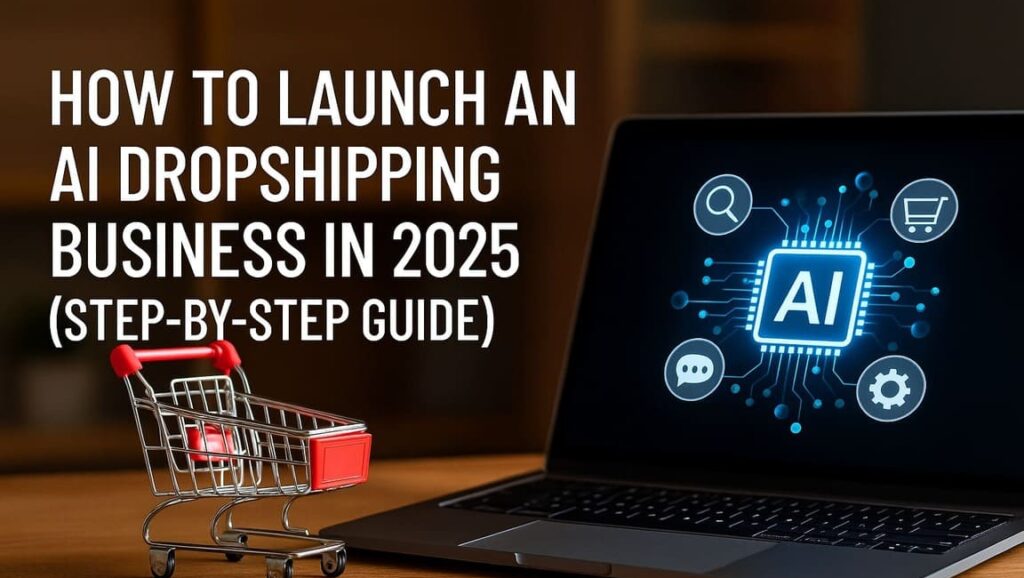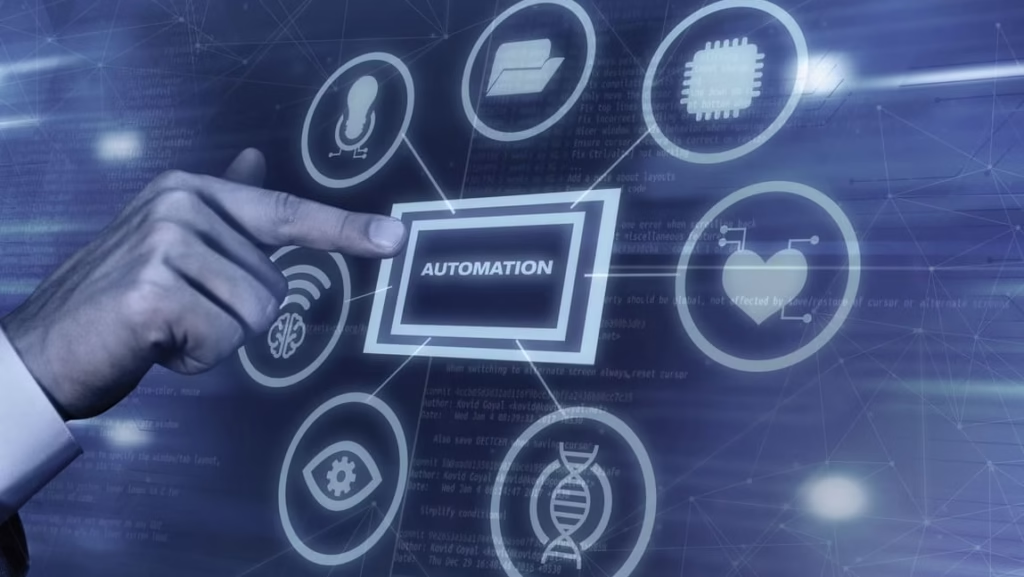Why AI and Dropshipping Are a Perfect Match
The AI dropshipping business model is quickly becoming one of the most profitable and scalable opportunities for aspiring entrepreneurs in 2025. If you’ve been thinking about starting an online store but feel overwhelmed by the competition or complexity, AI might be your biggest advantage.
Artificial intelligence eliminates guesswork, automates tedious tasks, and provides real-time insights that help you make smarter decisions—fast. Whether it’s choosing products, managing inventory, writing product descriptions, or launching ads, AI tools are changing the dropshipping game forever.
In this step-by-step guide, you’ll learn how to launch a high-converting AI dropshipping business from scratch using today’s most powerful tools and strategies.

Related Read : Best AI Business Ideas You Can Start Now: Turn Tech Into Income in 2025
What Is Dropshipping and How Has AI Changed It?
Traditional Dropshipping Model Explained
In the classic dropshipping setup, you sell products through an online store without ever handling the inventory yourself. When a customer places an order, the supplier ships the product directly to them.
The model is low-risk and low-cost—but it’s also labor-intensive and competitive. Finding winning products, writing copy, fulfilling orders, and managing customer service often take hours every day.
How AI Optimizes Every Step of the Process
Enter artificial intelligence. AI streamlines dropshipping by:
- Predicting high-demand products before they trend
- Writing SEO-friendly descriptions in seconds
- Running targeted ad campaigns with smart segmentation
- Managing inventory, returns, and customer support
In short, AI turns dropshipping from a manual hustle into a data-driven system you can run at scale.
Planning Your AI-Driven Store the Smart Way
Choosing a Niche with AI-Powered Research Tools
Your niche can make or break your store. AI tools like Sell The Trend, Exploding Topics, and Shopify Trends scan massive datasets to recommend products that are gaining traction—before they go viral.
These tools analyze buyer behavior, seasonality, and even competitor performance, helping you focus your store around real demand.
Identifying Trends Before They Peak
Using AI, you can uncover micro-trends based on:
- Search volume changes (via Google Trends or Ubersuggest)
- Social media mentions (via BuzzSumo or TrendHunter)
- Historical price and sales data (via JungleScout or Helium 10)
This means you won’t waste time chasing saturated niches.
Related Read : Top 10 AI Tools You Should Be Using in 2025: Game-Changing Picks for Productivity & Growth
Finding Reliable Suppliers Using Smart Tools
AI Platforms That Vet and Monitor Suppliers
Platforms like DSers, Spocket, and AutoDS now integrate AI to score suppliers based on:
- Delivery times
- Product quality
- Customer feedback
- Order accuracy
This reduces the risk of dealing with unreliable vendors.
Automating Product Import and Syncing
With one click, you can import products from your supplier’s catalog to your store—complete with photos, specs, and even auto-updating prices. AI ensures your listings are never out of date.
Writing Product Descriptions and Ads Using AI
Tools That Generate SEO-Optimized Content
Apps like Jasper AI, Copy.ai, and WriteSonic create compelling, keyword-rich product descriptions in your brand’s tone. These tools write faster than a human and often outperform them in A/B tests.
Customizing Tone and Style for Your Brand
AI copywriters can be trained on your previous content or adjusted based on your audience—fun, professional, minimalist, luxury—you name it.

Related Read : Top Laptop Deals USA 2025: Best Picks Under $1000
Building Your Online Store with AI Tools
Shopify, WooCommerce, and Smart Integrations
Most e-commerce platforms now integrate with AI-powered apps for design, layout suggestions, and customer behavior tracking. Shopify even suggests product categories and app integrations based on your niche.
AI Chatbots for 24/7 Customer Support
Tools like Tidio, ManyChat, or Zendesk AI can:
- Answer FAQs
- Recommend products
- Track orders
- Upsell during conversations
This keeps your customers happy—even when you’re sleeping.
Automating Order Fulfillment and Tracking
Real-Time Updates Without Manual Input
Once an order is placed, AI can automatically:
- Send the order to the supplier
- Update inventory
- Notify the customer
- Provide tracking information
Apps like AutoDS, Oberlo (legacy), and AliDropship handle this seamlessly.
Handling Returns and Customer Inquiries with AI
Chatbots and automated ticket systems can now identify customer issues and guide them through return processes with minimal human involvement AI dropshipping business.
Related Read : Top Smartphone Deals : Best Picks Under $500
Smart Marketing for Your Dropshipping Business
Running AI-Driven Facebook and Google Ads
AI marketing tools like AdCreative.ai, Pencil, and Meta Advantage+ can:
- Generate ad creatives
- Optimize audience targeting
- Predict high-performing campaigns
- Adjust budgets in real-time
This eliminates the guesswork and reduces wasted ad spend.
Email Marketing Funnels Powered by AI Insights
Use platforms like Klaviyo, Mailchimp, or ActiveCampaign to automate email flows based on:
- Abandoned carts
- Purchase behavior
- Time since last visit
AI personalizes emails and boosts open rates with smart timing.
Analyzing Your Store’s Data Using AI Dashboards
Understanding Buyer Behavior and Sales Trends
AI dashboards (like Triple Whale or Google Analytics with GA4 AI integrations) break down your sales data into digestible insights. See:
- Best-performing products
- Repeat customer rates
- Checkout abandonment patterns
Adjusting Pricing and Inventory Automatically
Dynamic pricing tools can adjust prices in real-time based on competitor pricing, inventory levels, and demand spikes—maximizing your profits automatically AI dropshipping business.
How Much Does It Cost to Start an AI-Powered Dropshipping Store?
Startup Budget Breakdown
| Item | Estimated Monthly Cost |
|---|---|
| Domain & Hosting | $10–$20 |
| Shopify/WooCommerce | $29–$79 |
| AI Tools (Copy, Ads, Chatbots) | $50–$150 |
| Ad Budget (Initial) | $200–$500 |
| Misc (Apps, Images, Legal) | $50 |
A smart AI dropshipping business can launch with under $500, and scale without massive overhead .
Where to Invest and What to Automate First
Prioritize tools that:
- Save time (AI copywriting, automation)
- Drive sales (ad optimization, email flows)
- Improve user experience (chatbots)
Related Read : Best Online Courses for Remote Workers in 2025 USA
Common Mistakes New Sellers Make (And How AI Can Prevent Them)
Relying on Gut Instead of Data
Many beginners choose products they like, not what sells. AI helps you focus on what the market wants, not what your intuition says.
Neglecting Customer Experience
Automating order updates, fast responses, and helpful chatbots lead to better reviews—and better sales.
Tools You Need to Succeed in 2025
Best AI Tools for Product Research and Automation
- Sell The Trend
- Jasper AI
- DSers
- AdCreative.ai
- Tidio
Top Dropshipping Platforms Compatible with AI
- Shopify
- WooCommerce
- BigCommerce
- AutoDS
- AliDropship

Related Read : Top 10 AI Tools for Content Creation in 2025: Boost Productivity & Creativity
Frequently Asked Questions (FAQs)
What is an AI dropshipping business?
It’s a dropshipping model that uses artificial intelligence tools to automate product research, marketing, fulfillment, and customer service.
Is AI expensive to implement for dropshipping?
No. Many AI tools offer free trials and low-cost plans. You can start with under $500 total investment.
Can I run a dropshipping store solo using AI?
Absolutely. AI allows one person to manage an entire store—design, marketing, support, and fulfillment.
How quickly can I launch a store?
With AI tools, setup can take less than a week. You can be live and making sales in days, not months.
Is dropshipping still profitable in 2025?
Yes—especially if you use AI to cut costs, identify trends, and optimize ads faster than competitors.
Do I need to know how to code or use AI?
Not at all. Most tools are beginner-friendly, with intuitive dashboards and plug-and-play features.
Conclusion: Make AI Your Secret Weapon in Dropshipping
Launching an AI dropshipping business in 2025 is not only possible—it’s practical, profitable, and perfectly suited for solopreneurs. The tools are smarter, cheaper, and more accessible than ever before.
You don’t need a warehouse. You don’t need a big team. You just need the right idea—and the right tech.
Make 2025 the year you build an automated, income-generating store that runs smarter—not harder.




